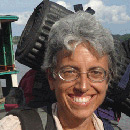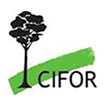
Late one sunny afternoon in September, in teacher Kim Spencer’s ninth-grade class, groups of students raced each other to guess the names of animals from a description of their characteristics.
“Caiman!” called one student. “Anteater!” said another.
The game was part of the first session of a year-long environmental education course being pilot tested in four schools in Guyana’s southern Rupununi region.
When Spencer was just a little younger than her students, members of a local conservation group took her into the grasslands and forests of the rolling Rupununi savannah, where she learned to identify birds, map their habitat and describe their behavior.

“I got to love bird watching,” says Spencer, 20, who became a community conservation ranger.
Now, as a teacher at the secondary school in the village of Sand Creek, she aims to instill similar passion in her students, using a curriculum developed by the South Rupununi Conservation Society, the same organization that taught her about valuing local wildlife.
The development and pilot testing of the curriculum are supported by the Guyana branch of the Sustainable Wildlife Management (SWM) Programme, which is working to improve the conservation and sustainable use of wildlife in forest, savannah and wetland environments in 13 countries.

Students at Sand Creek Secondary School identify local wildlife on posters during the launch of the new environmental education curriculum. CIFOR/Barbara Fraser
The weekly sessions will take students out of the classroom and into the savannas, bush islands and forests around their village, where they will learn to use binoculars, record observations, set camera traps to photograph wildlife, and analyze the data they collect. Local resource people will bolster scientific knowledge in the program by helping Spencer share stories and pass on local knowledge and skills to the children.
At schools like the one in Sand Creek, a lack of resources means there are few opportunities for hands-on education, Spencer says.
“When they’re doing things, they learn more,” she adds. “Some do not like science. I hope it will help them enjoy science, and that by the end of the semester they understand the importance of the environment.”
Countering change
The curriculum was developed by a group of young local conservationists, some of whom are the children of the conservation society’s founders, who grew up with a deep appreciation of the Rupununi, with its wildlife, beauty and culture.
In just a generation, however, they have seen significant changes in their surroundings.
As indigenous communities have increasing contact with other parts of Guyana and with neighboring Brazil, hook-and-line fishing has given way to nets that catch more fish with less effort, decimating stocks. Animals like giant anteaters and armadillos, which once were common, are now seen less frequently. And fewer Amerindian children learn their parents’ native language or skills like basket weaving, says Kayla de Freitas of SRCS.
The environmental education course builds on work the SRCS members have done with local schools in recent years in an effort to stem, or even reverse, that trend.

“These are crucial stages” for sparking young people’s interest in wildlife and traditional knowledge, de Freitas says of the elementary and high school classes that will pilot test the curriculum this year.
She and her colleagues hope that through the experience, students between ages 6 and 16 will become more aware of and active in conservation issues and that they will influence their parents, as well.
Parents attended the introductory lesson in Sand Creek, reviewing the materials and playing games along with their children.
Called “My Rupununi and Me: Our Culture, Skills and Knowledge,” the course consists of three sections. In the first, students learn about the region’s plants and wildlife, including the endangered red siskin (Spinus cucullata), a striking red and black bird that the SRCS has worked to protect.
The second section of the curriculum highlights ecosystems, including the aquatic, bush and savannah landscapes for which the Rupununi is known. Students will also discuss solutions to key environmental problems, including savannah wildfires and appropriate disposal of solid waste.
In the third section, students delve into their Amerindian heritage, with storytelling and traditional skills such as basket weaving, wood carving and cotton spinning. They also learn words and songs in their native languages. The program encourages pride in local knowledge by encouraging children to interview their elders and value their input into education.
More than science
The course will be offered in four schools this year, and the SRCS hopes to reach at least 16 by the time the SWM Programme ends in 2024.
At the end of each school year, students involved in the course at all the participating schools will gather with their families for a festival.
Villages throughout the Rupununi celebrate Amerindian heritage month each September, but the school festival, in July, will highlight conservation and the arts, as well as indigenous heritage, and will be centered on the children, says Neal Millar, SRCS program coordinator.
Although students will learn scientific research techniques in the course, the curriculum goes far beyond science to embrace language, social studies and other subjects, Spencer says.
By taking the students to the field to observe birds and other animals, record and analyze data, and write reports, the course will reinforce academic skills that the students normally learn by rote, including mathematics and English, she says.
Presenting the results of their investigations will give students more confidence about speaking in public, says Joshua Fredericks, who has launched the curriculum with students in fourth, eighth and ninth grade in the village of Shulinab.
Spencer remembers what it was like to learn to use binoculars, describe an animal’s habitat, measure distances or record observations about birds — skills she learned from SRCS team members.
“At first I had no idea how to do it,” she says, but she looks forward to sharing those skills with her own students through hands-on activities.
“When they’re doing things, they learn more,” she says. “I hope that by the end of the semester, they understand the importance of the environment, especially about conservation and sustainable use of wildlife.”
The Sustainable Wildlife Management (SWM) Programme is an African, Caribbean and Pacific Group of States (ACP) initiative funded by the European Union and implemented by the Center for International Forestry Research (CIFOR), the Food and Agriculture Organization of the United Nations (FAO), the French Agricultural Research Centre for International Development (CIRAD) and the Wildlife Conservation Society (WCS).
We want you to share Forests News content, which is licensed under Creative Commons Attribution-NonCommercial-ShareAlike 4.0 International (CC BY-NC-SA 4.0). This means you are free to redistribute our material for non-commercial purposes. All we ask is that you give Forests News appropriate credit and link to the original Forests News content, indicate if changes were made, and distribute your contributions under the same Creative Commons license. You must notify Forests News if you repost, reprint or reuse our materials by contacting forestsnews@cifor-icraf.org.












